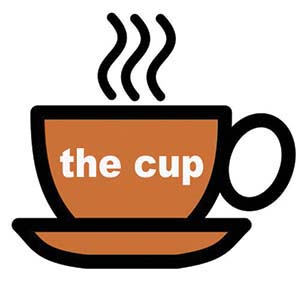Don Senneville and Jim White
Don’s been on another of his self-assignments, this time in Sedona (again). He reports a discovery in a subdivision in West Sedona, which is, appropriately enough, off Coffee Pot Drive. Coffee Pot runs straight north toward a red and tan rock formation, the right end of which is called the “Coffee Pot”. It takes a bit of imagination to see why it’s called that. But if you look hard, sure enough, it looks like a cowboy coffee pot – the right shape, spout to the right. The thing about this clutch of homes is that the streets are named for coffee companies.
We’re familiar with Sanborn, since it’s a larger street, but it wasn’t until Don found himself at the stop sign on the corner of Farmer Bros. and Nescafe that he thought he should look into the situation further. Starbucks Ave.? As one drives out of the ’coffee subdivision’ there are streets with names like “Flaming Arrow” and “Six-Gun” – yikes! Clearly not what we had in mind.
So, Don turned around, and got back into the coffee world. There’s Maxwell House, and Hills Bros. He thinks he might have seen Folgers Place. Don almost drove past two more (he admits his ignorance): One is Caswell. Turns out Caswell was George W. Caswell Coffee, in San Francisco in the 1930s. George put such things as coffee scoops and branded thimbles in his coffee cans as ‘prizes,’ like toys in cereal boxes. Think Cracker Jacks. He also set up a “Coffee Training School” in Jakarta as part of Boncafe, Indonesia, which sells coffee machines. They teach “Coffee Knowledge, Espresso Extraction Techniques, Workflow Management, Milk Texturing, and Machine Basic Training”. Wow! Who knew of such a rich coffee history in early Sedona. But Why?
Then there was Arbuckle Street. Here’s a bit of history on Arbuckles’ Coffee (from the company): Arbuckles’ Coffee began in the post Civil War Era of the 19th Century. Two brothers, John and Charles Arbuckle, initiated a new concept in the coffee industry: selling roasted coffee in one pound packages. Until that time, coffee was sold green and had to be roasted in a skillet over a fire or in a wood stove.
You can imagine the inconsistency of the coffee. One burned bean ruined the whole batch. The Arbuckle Brothers were able to roast a coffee that was consistently fine quality and the first to be packaged in one pound bags. Arbuckles’ Ariosa Blend became so popular in the Old West that most cowboys didn’t even know that there was any other. Arbuckles’ Coffee was prominent in such infamous towns as Dodge City and Tombstone. To many older cowboys, Arbuckles’ Ariosa Blend is still known as the Original Cowboy Coffee (our emphasis). Arbuckles’ still exists (at least in Tucson). We’ll see if anybody wants to challenge the Original Cowboy Coffee claim. Fatty Arbuckle must have been here..
Whew! Don kept looking. He came across a street called “Grounds”. Makes sense. Things sort of wandered off at the discovery of “Lipton Place.” What?
Then there was “Borden” – at least there might be some half ‘n’ half. Darjeeling Street? Tea Party Drive? Enough of Sedona’s hip coffee streets. There was no Decaf Way. Wrong part of town!
Upcoming events for THE CUP include (1) the first annual Dog Show planning meeting with the mayor and kid judges. (2) Local Barista goes to Europe to report on the coffee culture. And (3) we are headed to Bartlett Lake to assess the fire damage to our favorite camping coffee location.
Stay cool and try to enjoy an iced coffee or two. Contact us at the CUP at sonorannews.com.





